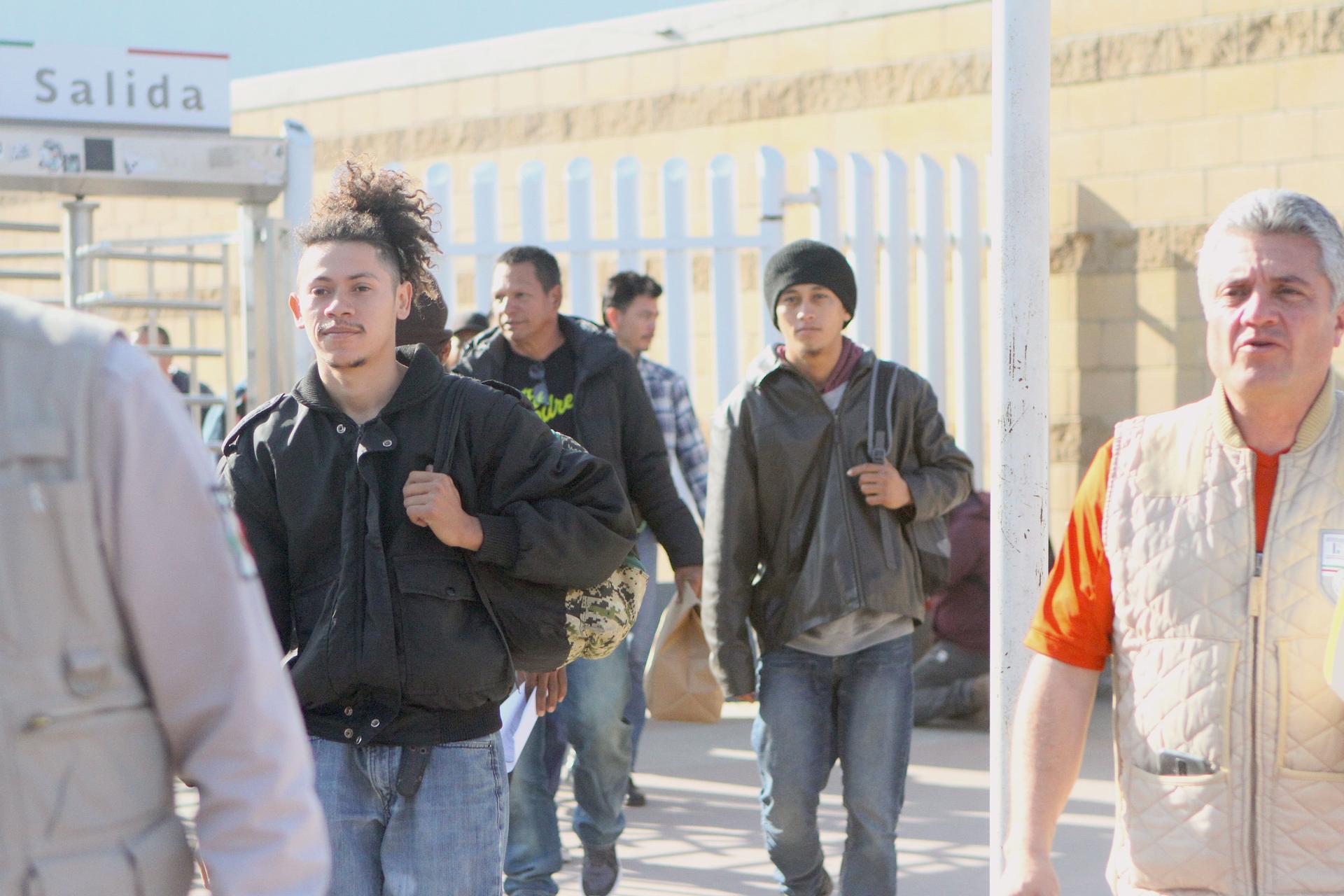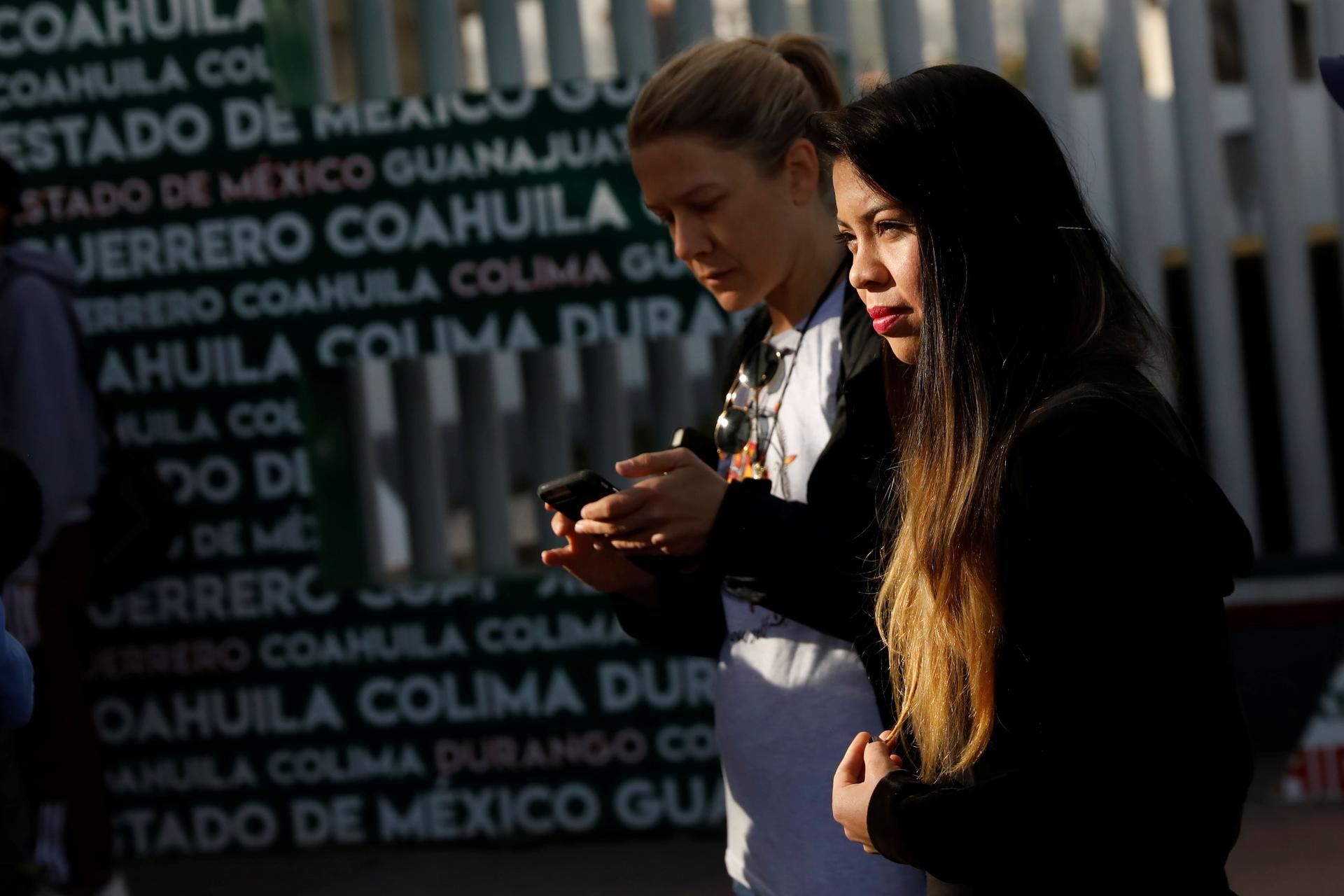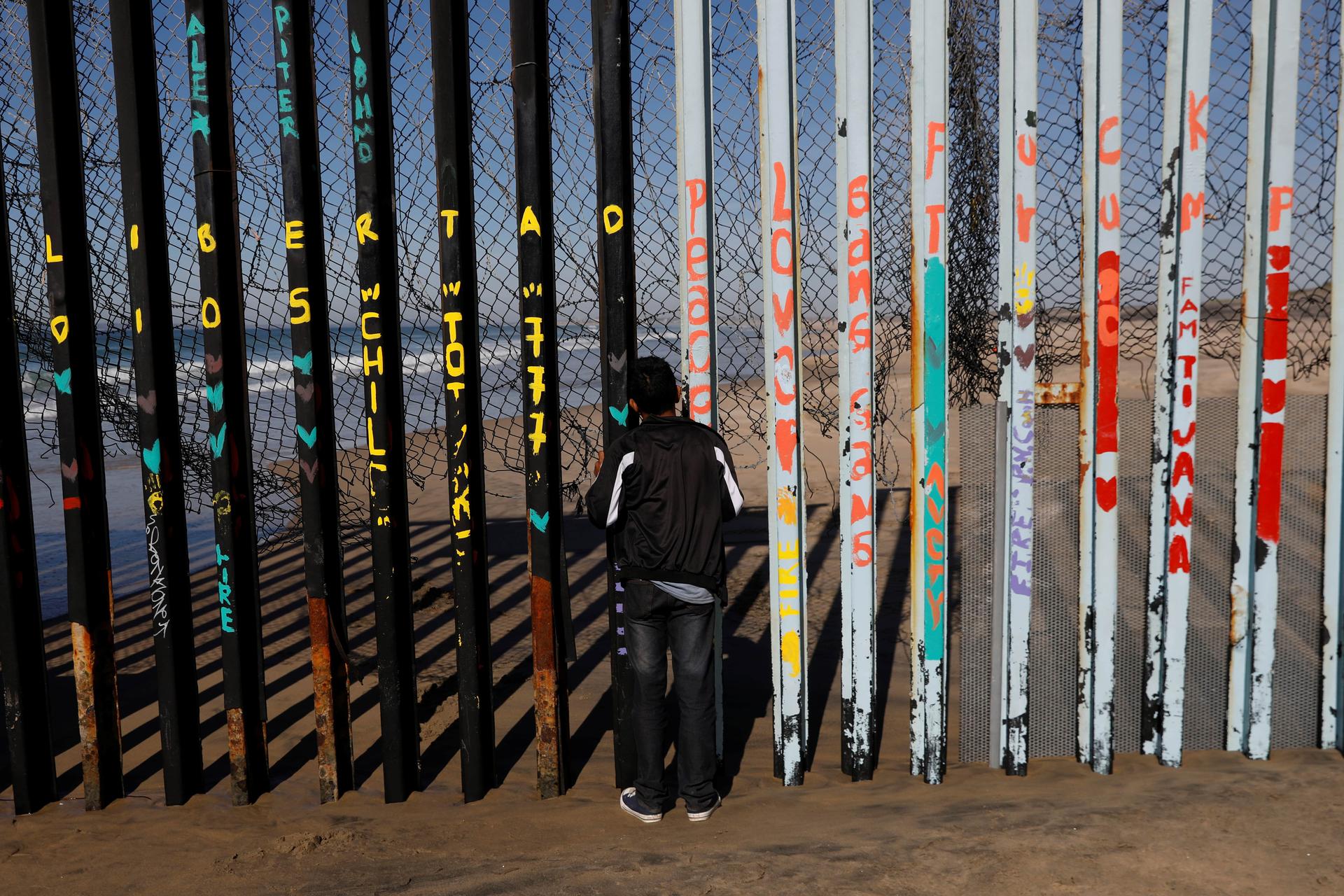‘They’re playing with our lives’ say the first migrants returned under new Mexico policy
A boy looks through the slats of the US-Mexico border fence at Friendship Park in Tijuana, Mexico, on Jan. 27, 2019.
A crowd of Nicaraguans, Haitians and Hondurans gathered Wednesday around two young men who had just shuffled into the dusty courtyard of a small shelter in northeast Tijuana, a Mexican border city.
“Why are you back?” a Haitian woman with a baby on her hip asked.
“The gringos sent us to wait here,” one answered, visibly annoyed. “I don’t know why they picked us.”
The day before, the Honduran men, Alonzo and Ariel, had left to apply for asylum in the United States. But that afternoon, US officials returned them to Tijuana as part of a new Trump administration policy known as “Remain in Mexico,” under which Central American asylum-seekers are forced to wait in Mexico while their asylum cases are decided in the United States. They were sent back with a packet of legal information mostly written in English, a language they do not speak.
Officially called the Migrant Protection Protocols, the policy has drawn criticism over human rights concerns and logistical questions about where the migrants will live, whether they will be safe and how they can manage high-stakes, US asylum cases while living in another country — worries that have not been assuaged in its first days. The rollout has appeared chaotic, ad hoc and confusing to those who have been processed so far. Meanwhile, legal service providers feel their efforts are being restricted as two US attorneys from Al Otro Lado, a cross-border legal organization, were denied entry to Mexico in recent days.
It is one of the most severe changes to the US immigration system in decades, and the most recent attempt by the Trump administration to discourage people from legally seeking asylum in the United States. It is sure to be challenged in court.
Related: As United States’ ‘Remain in Mexico’ plan begins, Mexico plans to shut its ‘too successful’ humanitarian visa program
A Department of Homeland Security guidance for the new policy states that migrants who enter the US — whether at a port of entry or after crossing the border illegally — will be sent back to Mexico. They will then be given multiple-entry permits to wait until their first US court date, which is to take place within 45 days. DHS says they will receive a decision within a year. Those whose claims are denied will be deported to their home countries. While the guidance says the policy will exclude “vulnerable people,” among those already returned was a lesbian — a population with a well-documented history of being targeted in Mexico.
The policy began Jan. 29 with a slow trickle at the US port of entry at San Ysidro, which connects San Diego and Tijuana. Twenty-three Central American adults have been turned back so far. A single Honduran man was returned the first day. The next: 10 men and one woman. Day three: two men. Over the weekend, no one. On Monday: seven men and two women. In the coming weeks, it will expand to several ports of entry along the border and soon return families with children, as well, DHS officials told reporters Friday.
It remains to be seen whether Mexico will accept the expansion. The head of the country’s immigration agency told the press the policy would be restricted to the border crossing in Tijuana and that Mexico would admit only Central Americans between the ages of 18 and 60, excluding unaccompanied minors and families who are arriving to the border in rising numbers.

‘They are playing with our lives’
Many of those affected were frustrated by the news.
“We came to live in the United States, not Mexico. They are playing with our lives,” Alonzo nearly shouted, sitting on a thin mattress in the half-finished cement basement of the shelter. “Why did they pick us out of the whole group? There were 47 of us that entered into a room, and 11 were sent back. Why? We suffered the same on the journey. It’s not fair that others are in a better process in the US, and we are here suffering. We just want a better life.”
Alonzo, 29, and Ariel, 19, who requested only part of their names be used to protect their privacy, had not heard about the policy before crossing into the United States. Instead, they expected to be detained for awhile and eventually be released into the US while they fought their cases. The former roommates from San Pedro Sula, Honduras, said they fled the country after death threats from the MS-13 gang for refusing to pay repeated extortion fees. They’d traveled with a tattered letter from MS-13 where the gang threatened their families would end up “wrapped in paper,” or killed, if they didn’t comply. The men hoped to show it to US authorities.
Ariel sat silently despondent beside Alonzo.
“I’m disappointed, and I’m worried. I can’t be here a year. I don’t want to be here that long … I want to cross legally.”
“I’m disappointed, and I’m worried,” Ariel said. “I can’t be here a year. I don’t want to be here that long … I want to cross legally.”
Several returned migrants also told The World that Customs and Border Protection officers are questioning them about how the Central American “caravans” are being organized and are splitting migrants into caravan and noncaravan arrivals.
Once migrants are sent back to Mexico, they are given the option to stay in a shelter or find their own lodging. Those running shelters say they are given little warning that returned migrants will be dropped off.
“I just got a call Wednesday morning saying that 10 people were going to show up … I was surprised because we didn’t know when it was starting,” said Sarai Martinez Castillo, director of the Salvation Army shelter in Tijuana, which has so far accepted three returned men. “If this keeps going, it will become complicated for the shelters in the city.”
The Mexican government has not announced plans or additional budget to deal with the potential influx of returned migrants. Local government and civil society representatives expressed concern about Tijuana’s ability to provide for all those returned, as shelters are at capacity. Thousands from last year’s caravan that arrived in November remain in the city, while members of a new caravan have begun to arrive. Meanwhile, the United States continues to limit the number of asylum-seekers it takes at ports of entry, creating a bottleneck in border regions.
The United States’ coordination with authorities in Mexico has been limited, according to Rodulfo Figueroa, head of Mexican immigration in the state of Baja California, where Tijuana is located.
Cities along the US-Mexico border are notorious for crime, and migrants are often targeted for robberies, kidnapping and extortion. In 2018, Tijuana experienced its deadliest year to date with a record 2,518 killings, making it one of the world’s deadliest cities. A US guidance issued last week noted that if a migrant slated for return says they are afraid to be in Mexico, they could possibly be exempt. But activists say the United States makes exemptions hard to get, as its rules put the burden on migrants to offer the information rather than on agents to ask.
Related: After two boys’ murders, migrants and advocates fear new ‘remain in Mexico’ policy
“It’s insulting that it’s even called the Migrant Protection Protocols when they are sending people back to one of the most dangerous cities in the world.”
“US authorities are not routinely asking people if they are afraid, so people would have to know to tell them,” said Erika Pinheiro, an American immigration attorney and Al Otro Lado’s director of litigation and policy who was denied entry into Mexico last week. “It’s insulting that it’s even called the Migrant Protection Protocols when they are sending people back to one of the most dangerous cities in the world.”
“It’s not just the high murder rate,” she added. “There is an unknown number of migrants who are trafficked or disappeared.”
Alonzo, Ariel and three other migrants returned under the policy each told The World that US authorities did not ask if they feared persecution or torture in Mexico before returning them.
Difficulty accessing legal counsel
Human rights advocates also worry asylum-seekers will lack access to legal counsel in Mexico while they wait for their US hearings. Before being released into Tijuana, migrants receive a packet that includes a notice to appear in court, a printout of their short interview with a CBP officer, logistical information and a list of legal service providers in the United States.
The page says they can “consult with the counsel by telephone, email, video conference,” or arrange to meet with them in Mexico, at their own expense. The entire packet is in English, with a sole page in Spanish stating the date and time of their first hearing and explaining migrants’ right to seek their own counsel.
At least three of those returned said CBP officers directed them to the Tijuana office of Al Otro Lado, though it was not on the list of providers. The small nonprofit of 12 formal employees runs on volunteers and provides group legal orientations to about 80 people per day with help from the Catholic Legal Immigration Network, Inc., or CLINIC.
But Al Otro Lado is not taking cases in Mexico, as their funding only allows them to represent people living in California. In fact, two of the organization’s directors were recently denied entry into Mexico after an unknown government placed alerts on their passports. One of them, Nora Phillips, was sent back to Los Angeles, where she is based. The other, Pinheiro, remains in the US while she applies for Mexican residency through her infant son, who is a Mexican citizen, while her partner remains in Tijuana.
The group’s Border Rights Project director, Nicole Ramos, said she viewed the move as a response to the organization’s work with migrants. Al Otro Lado, whose name means “the other side” in Spanish, is behind a high-profile lawsuit filed in 2017 alleging CBP and DHS have denied people the opportunity to apply for asylum at ports of entry.
While it is unclear who ordered the alert, the United States denies its role.
“There was no alert placed on their passports, and we refer to you the Government of Mexico,” said Katie Waldman, a spokeswoman for the Department of Homeland Security. Mexico’s immigration agency did not respond to a request for comment.

‘They are not being given any information’
The “Remain in Mexico” rollout has been just as confusing for migrants. Several who were returned said US officials did not fully explain the new policy. Alonzo and Ariel thought they would be allowed to stay in the United States after their first hearing. That is not the case.
“[Asylum-seekers] are being given complex documents that are not read to them or explained to them,” Ramos said. “They are not being explained to about what the process will look like when they are being returned for their first court date. … They are not being given any information.”
On the ground, activists and volunteers are scrambling to warn people about the change. At the border crossing each morning, they approach small clusters of migrants to explain the policy as they gather to add their names to a list of some 2,400 others already waiting to apply for US asylum — which could take up to six weeks. Some volunteers write lawyers’ phone numbers in black markers on people’s arms, should they need legal help once the US processes them.
The criteria for who the US is returning is unclear.
“People ask me, what are the chances of getting returned, and I have to tell them, ‘We really don’t know,’” said Alyssa Isidoridy, a lawyer with Human Rights First. “Some people have heard about the change, but others are in shock. Most people understandably don’t want to stay here, and they aren’t immediately sure what to do.”
Some say they see no choice, but to wait in Tijuana for the duration of their case, despite the danger. That includes Juli, a 24-year-old Salvadoran who put her name on the list of asylum-seekers along with five members of her family.
“We obviously would rather be in the United States and waiting, but if we have to wait, we will. The gangs threatened us, and all five of us living in the house left within a day. What’s our alternative?”
“We obviously would rather be in the United States and waiting, but if we have to wait, we will,” she said. “The gangs threatened us, and all five of us living in the house left within a day. What’s our alternative?”
Others say they would try to cross into the US another way.
“We don’t know about the new plan, we haven’t heard anything,” said Lilian, a 42-year-old Honduran woman whose eyes widened as she overheard another migrant talk about it. She and her husband, Wilmer, had just arrived from Honduras with their 3-year-old son after fleeing death threats from the 18th Street gang, a prominent criminal group with strongholds throughout El Salvador and Honduras.
“If it’s true we have to wait up to a year, I think we would try going illegally,” she said.
Sarah Kinosian reported from Tijuana, Mexico
Our coverage reaches millions each week, but only a small fraction of listeners contribute to sustain our program. We still need 224 more people to donate $100 or $10/monthly to unlock our $67,000 match. Will you help us get there today?
